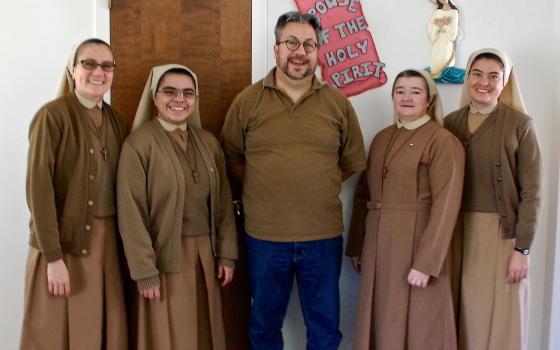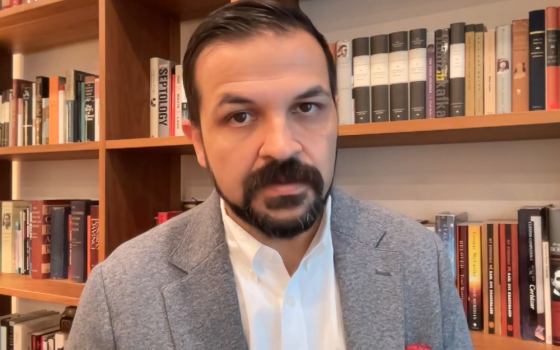
ESSAY
Anyone who has ministered to people who are suffering has probably encountered the anguished question: Why did God ... give this young mother terminal cancer? allow our child to be kidnapped and killed? inflict this hurricane upon an already earthquake-ravaged country? Conversely, there are those smug or masochistic or sadistic people who are sure they know exactly why God did something: God is punishing those perverts, God is testing my faith, God took your child to teach you detachment, and so on. This attribution of direct causality for mundane happenings to God can be a spontaneous reaction to bewilderment in the face of inexplicable evil and suffering, but it reflects bad theology and encourages worse spirituality. Before looking for traces of God’s influence in the present experience of the Vatican investigations of religious congregations and their leadership, it is well to unveil and repudiate any temptation to whitewash that experience under the rubric of “God’s will.”
The conviction that God governs the universe by direct miraculous interventions in everything from keeping the rain from ruining our picnic to permitting epidemics that decimate whole populations allows us to believe that “Someone” is in charge and therefore to blame (or to be thanked) for every happening, large or small. It convinces us that we are not really alone in a chance-driven universe. However capricious, cruel, inscrutable or violent we have to believe this “Universe Controller” to be, at least we do not have to face the terror that there is no all-powerful Hand on the cosmic tiller.
But eventually, if we are to mature spiritually, we have to surrender this magical approach to reality, this need for “Someone” who can be held responsible for what we cannot fathom or control, whom we can blame or cower before or bribe or cajole in the face of life’s uncertainties. We have to face the fact that germs, atmospheric conditions, the movement of tectonic plates, human malice or stupidity (our own or someone else’s), just being in the wrong place at the wrong time, or myriad other factors that we do not even know about and that God is not manipulating by some giant computer in the sky -- in other words, cause and effect in the finite space-time continuum in which we live -- account for “what happens” that is outside our knowledge or control or that is contrary to our will.
God is always present to us, more intimate to us than we are to ourselves, deeply and lovingly concerned about us down to the very hairs on our head (Matthew 10:30). God is supporting us, urging us to the best responses to reality of which we are capable and even beyond what we think we are capable of, consoling us in suffering, sharing and affirming our joy, strengthening us in conflict, and enabling us to learn and grow through everything we experience no matter how tragic or overwhelming it may be. But this does not make God the direct and immediate cause of each event that happens in the universe.
This is what we learn from the crucifixion of Jesus. God did not will the unmitigated evil of the murder of Jesus, much less kill him for our sakes. Jesus’ murderers were not God’s secret coworkers or disguised instruments of the divine will, and deicide is not the cause of our salvation. But God was with Jesus right through death itself and, by raising Jesus from the dead, set the seal of divine approval on Jesus’ free choice to give life to us, even at the cost of his own. This central event of Christian experience, God’s drawing the salvation of the world from Jesus’ willing acceptance of the absolute evil wreaked upon him by demonically inspired human hatred, is the pattern of what we call the “paschal mystery,” the victorious emergence of life from the very bowels of death. Death does not cause life, but life triumphs even over death because life is of God. In short, bad causes, whether natural disasters or accidents or stupidity or human evil, do not produce good results, but human beings dealing courageously and creatively with natural or moral evil can cause great good to emerge for themselves and others.
Christians down through the ages have shared in this paschal mystery in large and small ways, following in the footsteps of the crucified and risen Jesus. How often we have heard people say, “I’d give anything in the world not to have done what I did ... not to have suffered this loss ... not to have been the victim of ... But I would not have become the person I am today if that tragedy had not entered my life.” Christianity is not a masochistic glorification of victimhood, much less a sadistic divine infliction of suffering “to build character.” It is not the case, for example, that the domestic abuse of this woman was a good thing because it “enabled” her to take charge of her life. She, her courage and determination, God’s grace, perhaps the help of others and resources available at the right time and place, not her being abused, are what enabled her to rise out of a hell of evil and choose life. And the lack of those resources might make another woman unable to escape the evil but still able to keep her integrity in the midst of it. And a third might simply succumb to the evil. In no case does faith make evil good. But faith can make suffering meaningful, struggle worthwhile, victory affirming, and even the acceptance of what we cannot surmount life-giving, as they were for Jesus.
Many people, in and outside religious life, are beginning to realize that two Vatican investigations of U.S. women religious and their leaders -- investigations that have caused enormous expenditures of material and human resources, sidetracking of valuable time and energy of congregations and their leaders, distraction from ministry and community life, while generating widespread anxiety, especially among religious living the final days of decades-long lives of fidelity and dedication to God’s people -- have nevertheless been the context for some very positive developments. These developments were clearly not intended by the investigations and certainly not caused by them. But God is not limited by human intentions and, like the woman who takes charge of her life in a way she would not have had she been in an even minimally tolerable marriage, religious well beyond the limits of the targeted object of the investigations are taking hold consciously of their Second Vatican Council-inspired identity and mission in a powerful new way. It can be life-giving to pay attention to some of these developments even as we clearly recognize and affirm them as the work of the Spirit strengthening our spirits to endure suffering and grow through it, not the product of human intimidation.
Perhaps the most important development is the impetus, given by the suspicion cast on American religious life by the very launching of the investigations, to articulate much more clearly the theology and spirituality that has developed in and energized the last 40 years of ministerial religious life in this country. Religious during these decades were busy living their way into a new stage in the history of their life and sharing their life with the people to whom they ministered. But the calling into question of the integrity of their personal and communal lives, the fidelity of their commitment to church and religious life, and the efficacy of the renewal they undertook in response to the council’s invitation and mandate, has stimulated an overdue effort to speak their truth clearly to themselves and in the assembly of the people of God.
A second development is that this self-articulation has resonated deeply with the actual experience of women religious in and by the U.S. church and this has elicited a spirited expression of appreciation and support of the sisters by many thousands of lay Catholics and some of the clergy. Not only are sisters not seen as lax, unfaithful, in need of investigation of the “quality of their life” and in need of correction (or perhaps even suppression) by a hierarchy that could be better employed examining its own affairs, but they are seen as sources of inspiration and support by millions of Catholics who themselves have been trying to internalize the teaching of Vatican II and to live its spirit in their families, parishes and professional settings. As the laity has sprung to the support of the sisters, the sisters have realized in a new way how intimately connected their life has become to that of their lay sisters and brothers. Both groups have affirmed and rejoiced in their life-giving solidarity, especially in a scandal-ridden church whose institutional integrity is in shambles and whose public agenda is increasingly restorationist.
A third paschal development has been the recognition by religious of the deep unity among themselves, across congregational lines, that has developed in the wake of the council. If there was a time in the past when religious thought of themselves first as members of their own congregations, not only distinct from but even in competition with other congregations, that time is long past. For decades, religious have been ministering together, sharing resources and facilities, looking to each other for support and affirmation when it often was not forthcoming from ecclesiastical authorities. But that solidarity has come to new expression in the past two years as all religious have found themselves together under a cloud of implied censure. The stunning courage of the Leadership Conference of Women Religious, already under investigation and therefore with good reason to think first of its own safety, in supporting the effort to pass health care reform legislation for millions of unprotected Americans, was a remarkable expression of cross-congregational solidarity and unified leadership in ministry. At this point religious tend to see themselves first as religious and then as Sisters of St. Joseph or the Immaculate Heart. We now know that there are 60,000 of us, and that is a formidable cohort for speaking truth to power and promoting justice for the voiceless.
An amazing development that can only be the work of the Spirit has been the emergence into voice of religious throughout the world -- especially in the two-thirds world -- expressing their support for and solidarity with their U.S. sisters under siege. The statements of support from the International Union of Superiors General and from the religious of Asia and Oceania, as well as from other groups of religious who have all risked “guilt by association” for their loyalty to their American sisters, have been humbling and exhilarating for U.S. religious, perhaps used to a leadership role among religious but less to being the beneficiaries of the support and care of religious from other parts of the world. As I have traveled nationally and internationally over the past two years I have been surprised -- and yet not surprised -- at the concern for, the solidarity with, the support of religious all over the world in regard to American religious. We are not merely 60,000 strong but many times that. And the vast majority of us are very much on the same page in our response to the challenges of the council to be a new church in and for and with the world that God so loves.
There are other developments emerging, not as clear or unambiguous, but worth watching. Have we been underestimating the immense vitality of that cohort of vigorous women who are being studied increasingly by sociologists as the subjects of a new developmental life stage that has enormous potential for world culture, the so-called “third-agers”? These people, who will soon be the largest and fastest-growing age cohort in the world, are healthy, active and engaged people who are between 65 and 90, which is precisely where the bulk of women religious are today.
Are we taking time to interact with younger women who, as they were growing up, may not have known personally any sisters and perhaps thought of them as timid and domesticated “good little nuns” or “father’s little helpers” but who now are hearing and reading about educated and powerful women religious committed to a Vatican II church and a redeemed world? Are we inviting them to think about women living community as equal adults, who are deeply Catholic but not institutional functionaries, who are fully involved in both the single-hearted quest for God and full-time commitment to the development of a new world of peace and justice, and who are not owned by, nor cowed by, nor beholden to male power? Do we have something to offer to our younger sisters that we have not articulated with sufficient clarity but that we are responsible to pass on to new generations?
Adversity often calls out of people conviction, strength and commitment that they were not conscious of possessing. That does not make adversity, especially gratuitous adversity caused by human beings, a blessing, even a “blessing in disguise.” It may well take considerable time, even after these investigations are a vague and distant memory, to fully realize what we have learned from this experience. At the very least it should make us newly aware that the gift of religious life is indeed, as the council called it, a gift -- to the church itself, to those called to it, to those to whom religious minister -- and that such a gift should not be taken for granted.
[Sandra M. Schneiders, a member of Sisters, Servants of the Immaculate Heart of Mary of Monroe, Mich., is a professor of New Testament Studies and Christian Spirituality at the Jesuit School of Theology, Berkeley, Calif.]


